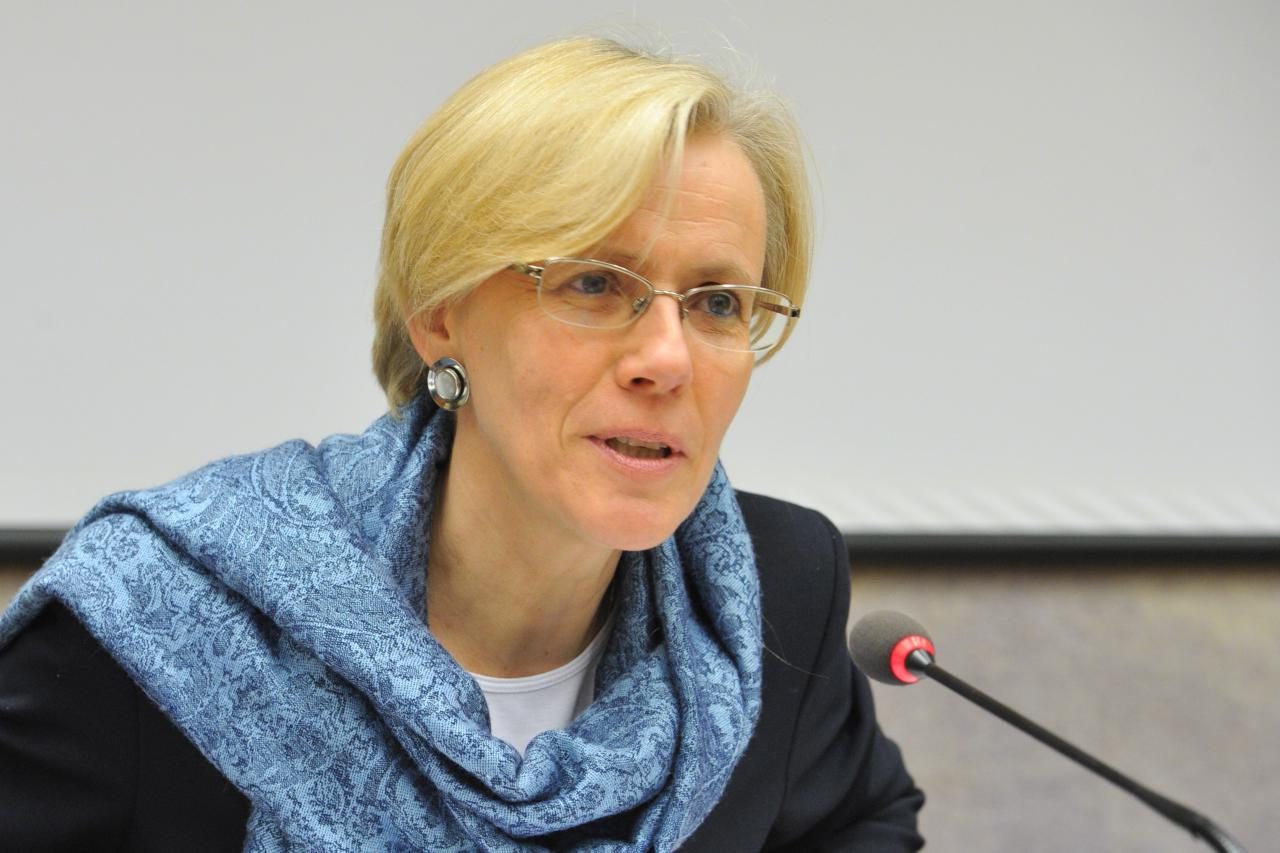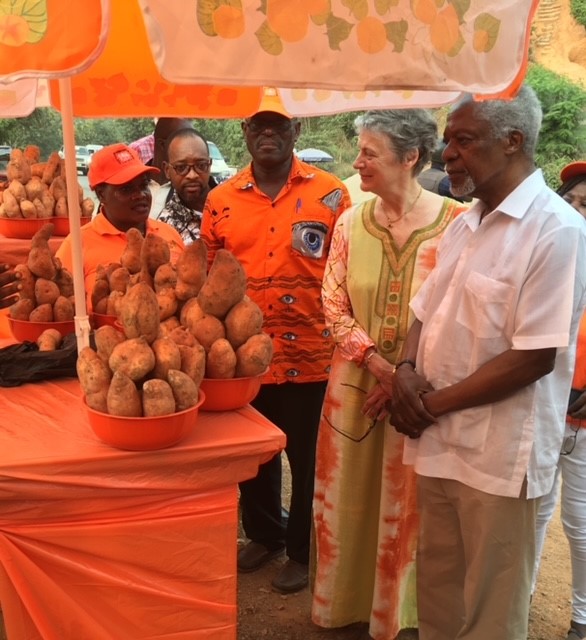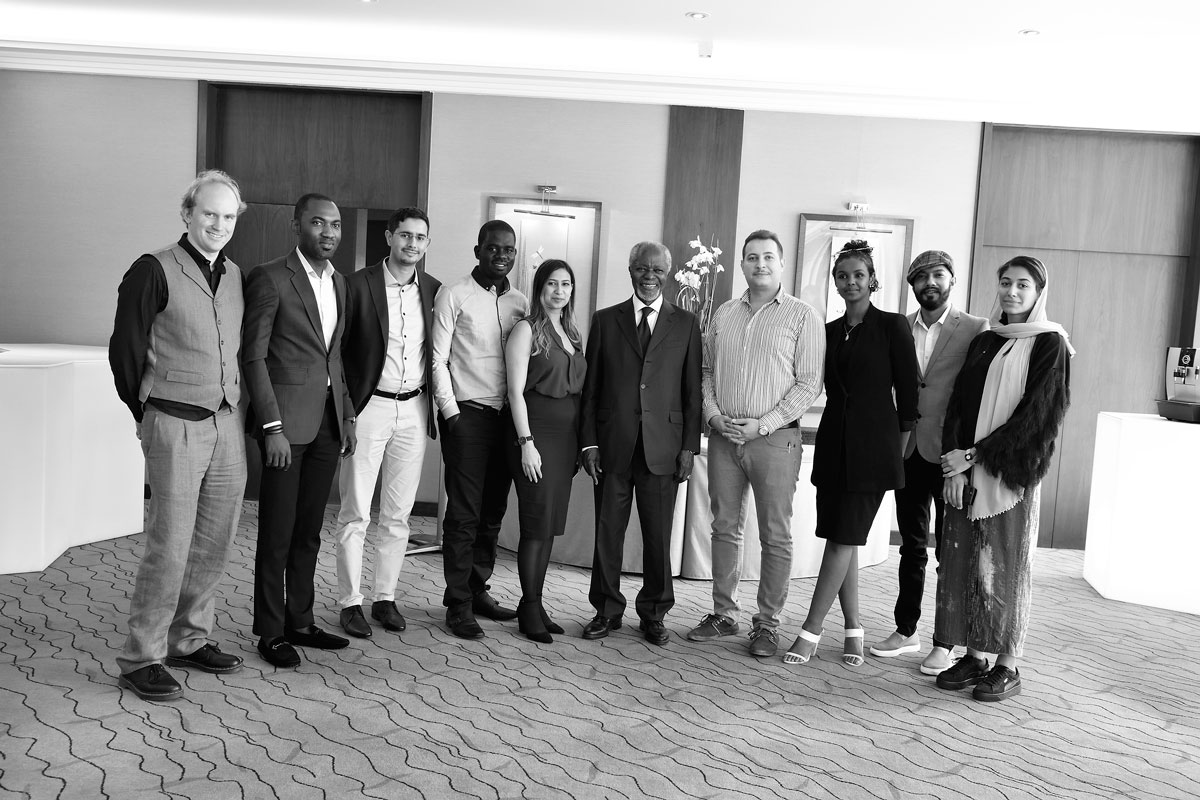Taking it to the Farmer: Speeding the Forces for Change to End Hunger in Africa
Thank you for that warm welcome.
I am deeply honoured to be here today to pay tribute to our 2010 World Food Prize Laureates and, on the eve of World Food Day, to examine where we are in the global fight to reduce hunger.
Can I start by offering my warmest congratulations to David Beckman and Jo Luck on winning this most prestigious and meaningful of awards.
Your work and commitment reminds us all that life’s greatest calling is to serve others and particularly to help them enjoy their basic human rights.
This includes, of course, the right not to go hungry.
That is why it is so distressing that one billion of our fellow human beings will today go without sufficient food.
The scale of the challenge was underlined last month when world leaders met to review progress on the Millennium Development Goals.
They heard that while the proportion of people suffering from hunger is declining, the pace of progress remains unsatisfactory.
Without coordinated and urgent action, the most basic goal of reducing poverty and world hunger is at risk of not being met by 2015 in many countries.
Closing this gap is not just a moral imperative.
It also lies at the core of a more secure and equitable world.
It is why we should be relieved to see an unprecedented global effort with a common purpose and big ambitions.
The aim is not only to feed the hungry today but to eliminate hunger by creating a sustainable, secure and global food system.
Achieving this ambition will require fundamental reform of economic and social policies across the planet.
With the world’s population continuing to grow, food and nutrition security is a challenge for every country.
There remain too many countries where people go hungry and many more where the threat of food shortages is all too real.
But there is one continent where the challenge is particularly urgent and serious.
Africa is the only continent which does not grow enough food to feed itself.
It alone has failed, in recent decades, to see agricultural productivity keep pace with its growing population.
Unfortunately, Africa was bypassed by the science-based agricultural development, built on the ideas of Norman Borlaug, which so dramatically transformed food production in Asia.
Africa is also the continent most threatened by the impact of climate change.
Increasing temperatures and changes to rainfall patterns are increasing water stress and risk, making many millions of acres of land much less productive in the future. Indeed, such changes are already underway.
So it is the challenge for agriculture in Africa on which I want to focus today.
It is a challenge which can only be overcome by working in partnership with the continent’s smallholder farmers.
For in Africa, as across much of the developing world, the agricultural system is powered by smallholder farmers.
More than three-quarters of Africa’s population is engaged in agriculture and related activities.
The vast majority of these farmers are women, mostly on small farms of two hectares or less.
But while agriculture contributes one-third of the continent’s GDP and provides most of its food, it has received, for too long, minimal support.
African governments in the final decades of the last century pulled back from desperately-needed investment in agriculture, at a time when the private sector and market forces were unable or unwilling to fill the void.
Public expenditure for agricultural research and development, for farmer training and support of almost every kind, was slashed.
The impact of these policies by national Governments was made far worse by a dramatic downturn in ODA support for agriculture by the world’s richest nations.
The result was that smallholder farmers struggled to access both the knowledge and resources needed to improve their crops and farms.
They were forced to rely on poor seeds planted in depleted soils.
Poor management of land and water resources, along with weak national and regional economic and infrastructure links, also held back agricultural development.
And African farmers also found themselves severely disadvantaged by an unbalanced global trade regime which sets up barriers to potential export markets, prevents the development of food industries while allowing surpluses to be dumped on the continent.
The result of all these factors was falling agricultural productivity, farmers trapped in poverty, growing shortages of food and millions more going hungry.
It was to address all these problems – and to understand why the lessons learnt from Asia’s successful agricultural transformation had not touched Africa – that as UN Secretary-General, I commissioned a study from the Inter Academy Council.
The conclusions and recommendations of that study have led to the concept of a “Uniquely African Green Revolution” – modern and sustainable agriculture with an emphasis on improved seeds and integrated soil fertility and water management practices.
And by basing the revolution firmly on small-holders, it builds on Norman Borlaug’s pioneering principle that food and nutrition security was best achieved by integrating agricultural research into appropriate technologies for farmers.
It was to play my part in helping bring this transformation about that I was delighted to accept, on leaving the UN, the invitation to chair a new organization – the Alliance for a Green Revolution in Africa or AGRA.
It is early days yet. But I am very proud of the work that AGRA is doing, with our partners at the national and international level, to begin to turn these ambitions into reality on the ground.
Our aim is to help build the systems needed and strengthen the critical links in the entire value chain to make smallholder farming productive, sustainable and profitable.
We are doing this by identifying, supporting and extending proven, local solutions for the benefits of not just hundreds of farmers, but thousands and, eventually, we hope, millions.
In particular, AGRA is starting to work with countries, donors, NGO’s, and farmers’ organizations to develop and implement strategies in those areas with the greatest potential to become Africa’s bread baskets.
By concentrating resources and efforts in regions which can grow a large share of the continent’s staple food requirements, we hope to make the breakthrough needed to deliver food and nutrition security within Africa and eventually create surplus for global export.
What is also so important is that African governments have themselves recognized the economic and social benefits of investing in their farmers and the rural economy.
Seven years ago, they adopted the Comprehensive Africa Agriculture Development Programme.
This called on African governments to put a minimum of 10 percent of their national budgets into agriculture with the aim of achieving six percent annual growth rate.
This African impetus, along with the commitment to the Millennium Development Goals, spurred in turn a new drive by developed countries to support Africa’s agricultural growth.
Indeed, never before has there been such a collective drive for change.
This encompasses civil society organizations, philanthropic foundations and multinational corporations.
It includes the U.S. Administration’s Feed the Future Initiative and the G8 countries’ pledge at L’Aquila.
From the actions of governments, the Rome-based food agencies and the CGIAR to, first and foremost, the people of Africa, food and nutrition security now sits firmly and rightly at the top of the development agenda.
And, this unprecedented coalition is having an impact.
I saw some of this progress for myself when I recently visited farmers in Mali and heard from them the difference that access to high-yielding seeds and fertilizer are making to their livelihoods.
The transformation is remarkable. The potential is even more exciting.
Farmers are growing new varieties of sorghum, maize, and rice that are drought tolerant and disease resistant.
They are using seeds developed through conventional breeding techniques that can be shaped and developed by African scientists and institutions.
National agricultural research organizations, new seed companies and agro-dealer shops are all part of this transformation.
Farmers, who are also being trained in sustainable soil management techniques, are also coming together to help shape their future.
By organizing themselves in farmers’ organizations, small-holders are freeing themselves from their dependence on middle-men who can take up to 30% of the value of farmers’ crops.
These organizations are helping farmers improve access to storage, to information on market prices and, where necessary, to credit, so they are not forced to sell their produce when prices are low.
But more inspiring than hearing from them what a difference these changes are making today, were their hopes for the future.
They are confident that, with continued support, they can meet increased demands for their crops.
Similar programmes are at work across the continent, ensuring sustainable food production and changing people’s lives.
In Kenya, farmers have quadrupled production of maize and other crops by using lime to revitalize acidic soils.
Local lime companies have donated the cost of transporting soil nutrients.
Equity Bank has made finance available at favourable rates to farmers.
And the National Agricultural Research Institute is developing improved crop varieties and coordinating the entire effort.
This project’s success could reverberate across much of East and Southern Africa.
In the southern highlands of Tanzania, 700,000 smallholder farmers produced five million metric tons of maize in 2009, more than any other region of the country.
AGRA’s agro-dealer programme helped leverage additional government support.
The World Bank has been so encouraged by the results that it is now providing $160 million to expand the initiative.
In Malawi, greatly improved yields because of access to affordable fertilizers has led to the country becoming a net exporter of maize for the last four years.
But this success, which has been driven by targeted outside funding, in itself reveals the challenges that small farmers face.
We now need to see the sustained support and reliable markets in which to sell their crops to help this tremendous but still temporary success become permanent.
We are seeing as well the World Food Program working to expand market access by sourcing more and more of its food aid in Africa from local farmers.
One of the Programme’s regular trading partners, for example, is a group of women farmers in Kenya.
Through WFP, Bread for the World, Heifer International, and many other actors, the central role that women farmers play is finally being recognized.
But we must do more to help them by removing the barriers in their way.
We cannot forget that, the women who produce most of Africa’s food, are particularly disadvantaged economically and socially.
They are not considered heads of households, rarely have land title rights and their interests are all too often overlooked by traditional financial institutions.
We need practical measures from field to market to remove these obstacles so they have a voice and a stake right through the agricultural value chain.
This must include innovative ways of ensuring their experience and aspirations help shape agricultural policy
But it is not just women farmers who have found it difficult in the past to access investment.
Despite the huge importance of agriculture to Africa’s economies, the continent’s commercial banks typically extend less than 3% of their lending to this sector.
We have to put this right. Agriculture is a business. It must be financed like one.
The huge need to provide farmers and agri-businesses with affordable credit is beginning to be met.
AGRA and its partners have already mobilized $160 million in affordable loans from local commercial banks through credit guarantees.
This is unprecedented, and the effort to expand access will continue.
We are seeing as well investment in, and support for, agro-dealer networks which are building thousands of rural businesses across the continent.
These are helping millions of farmers in remote areas gain access to basic ingredients of success such as improved seed and fertilizers – as well as knowledge about their use.
Distinguished guests, the challenges remain immense. We are only at the start of a long and gruelling journey.
But the balance is changing. There was a real sense of optimism last month at the African Green Revolution Forum in Ghana which was attended by more than 1,000 partners.
They included government leaders and parliamentarians, bankers, civil society organizations, scientists and researchers, and farmers.
I also saw something I had never seen before in Africa – the attendances of company CEOs at an agricultural event.
It was an indication that the private sector is starting to realize the opportunities that this sector offers.
But even more impressive was the realization that fundamental change is now within our grasp. .
We left the forum with clear ideas on what must be accomplished to accelerate this green revolution.
There is a huge amount more to do. Many millions are still going hungry.
Populations continue to grow. Climate change is, almost by the day, adding to the pressures on Africa’s land.
But I remain very optimistic about Africa’s chances to turn the corner once and for all.
The way forward is clear. We need to build on our successes, listen to the farmers, innovate as we go, and scale-up what we know works.
Like any successful revolution, the goal must always be permanent reform.
It is a challenge which all of us must work to overcome. Because we all have a stake in Africa’s future.
Without a prosperous, stable and peaceful Africa, our ambitions for our world will not succeed.
We need African governments to stand by and support their farmers through resource allocation and the right policy environments.
But it is equally important that the developed world upholds its commitments to Africa’s development and continues to see agriculture as a priority for support.
The private sector, too, has a huge role to play to invest in the new opportunities opening up.
This includes investment in commercial farms which can both encourage economies of scale and foster the uptake of new technologies.
This is not a simple matter of big farms or small.
Indeed, when done responsibly, large scale farming systems can play an important role in directly supporting small farmers through technical advice and support and access to markets.
However, care must always be taken to ensure local communities are consulted and their rights to land and natural resources are protected.
As we know, this partnership approach has not always been followed in the past.
Ladies and gentlemen,
I don’t under-estimate the difficulties ahead or the distance we have to travel.
We will need to harness effectively all your talents and energy to help us reach the destination.
But if we stand together – governments, civil society, the private sector, the scientific community and farmers – and sustain our efforts, a unique African Green Revolution is within our grasp.
It will be a huge step towards banishing hunger and meeting our ambitions for a just and peaceful world.
And it holds out the hope that World Food Day will not in the future be a rebuke for the one billion who don’t have enough to eat but a celebration of a food and nutrition secure world.
Thank you.



